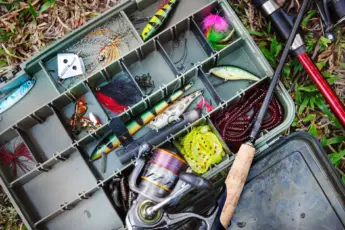A cubera snapper, otherwise known as a cuban dog snapper, is found in the coastal regions of North Carolina, South Carolina, and Georgia. The fish is sought after by recreational anglers in addition to commercial fishermen. Cuberas are fierce fighters and therefore give anglers a battle when the fish is hooked. Learn what a cubera snapper is.
How Do You Identify A Cubera Snapper
One of the most simple distinguishing factors is the size of the fish. While smaller juvenile cubera snapper are caught, the fish grows to be the largest in the snapper family. The fish tips the weight scales at over 120 pounds. However, the cuban dog snapper is most frequently caught between 30 and 40 pounds.
In terms of identifying the fish by sight, cautiously peer at the mouth. Never handle a cubera by grasping the fish by the lips. The mouth contains canine teeth. The teeth are visible despite the mouth remaining closed. Keep hands clear of the sharp cubera snapper teeth.
Faint vertical bars extend on each side of the snapper. Except for the bars, the fish is uniform in gray or dark brown.
Where Can I Find Cubera Snapper
Anglers catch cubera fish from Maine down to the Florida Keys along the east coast. The range of the fish is vast.
The juvenile cuban dog snapper remains inland before venturing to offshore waters. Offshore anglers catch cubera over reefs, rocks, and shipwrecks.
Is Cubera Snapper Good To Eat
Do you ever wonder can you eat cubera snapper? The cubera snapper is excellent eating. When the fish is filleted and prepared, the cubera snapper taste and texture are described as sweet, mild, and large tender flakes.
As a result of the taste and texture, the cubera or cuban dog snapper can be prepared in many ways. The most popular cooking methods include broiling, deep frying, and grilling. Considering the mild taste, avoid overseasoning the fillets.
Ciguatera Toxin And The Risks Of Consumption
Although the answer is yes to is cubera snapper good to eat, keep in mind that consuming cuban dog snapper presents a risk. Cubera pose the risk of containing ciguatera toxin. Fish become infected with ciguatera by ingesting a toxin.
There are no distinguishing characteristics of a fish that has contracted ciguatera. As a result, humans unknowingly consume the contained in the fillets.
When a human contracts ciguatera, the symptoms include neurological disorders, upset stomach, and vomiting. The symptoms range from days to years. A cure has yet to be identified.
Despite the inability to identify a fish with ciguatera, it is improbable that cubera snapper under 40 pounds carries the toxin. Therefore, when choosing to keep the fish, your best bet for deciding on what to keep and what to throw back is size. So while yes, is to are cubera snapper good to eat, the largest of them present a risk.
What Type Of Bait Do Cubera Snapper Eat
Diet significantly impacts the quality of fish fillets. Cubera feast on blue crabs, lobster, fish. Fish eaters hold high regard for the quality of the meat.
Rod And Reel Combinations
When it comes to cubera snapper fishing, it is essential to know that to land the fish, you must utilize stout fishing gear: Spool heavy spinning or conventional reel combinations with 50-pound test line.
Fishing Techniques And Location
In Georgia, South Carolina, and North Carolina, fish the offshore waters between 70 and 200 feet deep. Drop lead weights heavy enough to reach and hold the bottom over reefs, wrecks, and ledges. Tip the hooks with live crabs, lobster, or mullet. Vessels at anchor achieve the best results. However, drift fishing is also effective.
The cubera strikes aggressively and will utilize obstacles such as rough surfaces to cause aberration and break the fishing line. Reel the fish rapidly from the bottom to avoid breakoffs.
Icing The Fish After It Is Caught
While part of the challenge is understanding the proper gear, bait, location, and techniques to catch the fish, it is equally as important to understand how to keep the fish stored in ice.
To maximize freshness, head offshore with ample ice to keep the freshly caught snapper ice cold. A fish that is left to become warm risks spoiling or losing the quality of the taste that they are noted for.
Are You Heading Offshore Fishing For Cubera Snapper
The cubera snapper is challenging to locate. Catch rates are low when targeting cubera snapper specifically. The fish is difficult to locate; however, those who have the opportunity to battle the biggest snapper in the family are in for a fight. Remember to take caution when eating cuban snapper exceeding 40 pounds.







Leave a Comment
You must be logged in to post a comment.